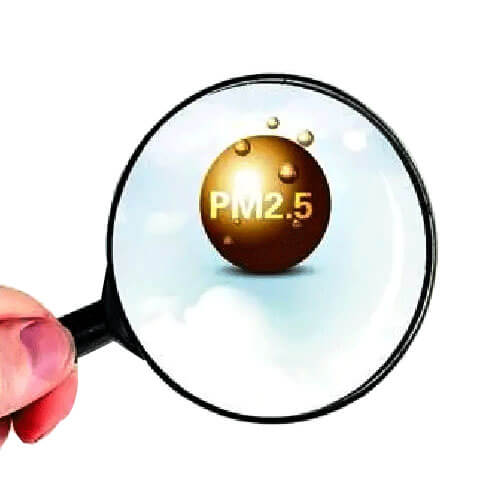Air is a precious natural resource. But air pollution is increasing due to industrial production and human activities. At present, air pollutants include carbon monoxide (CO), nitrogen oxides (NOx), hydrocarbons, sulfur oxides, and particulate matter (PM). Among them, the level of fine particulate matter (pm2.5) has become one of the important indicators for detecting air quality. PM2.5 are tiny particles in the air, and high pm2.5 levels can affect people’s health. Therefore, dust monitoring and reducing pm2.5 levels is important for the environment and human health.
What is pm2.5?
PM2.5 is particulate matter with a diameter of less than or equal to 2.5 microns in the atmosphere, also called particulate matter that can enter the lungs. Its diameter is less than 1/20 the thickness of human hair. PM stands for “particulate matter”. Although pm2.5 is only a small component in the atmospheric composition, it has an important impact on air quality and visibility. Compared with the coarser atmospheric particulate matter PM10, PM2.5 has a smaller particle size, contains a large amount of toxic and harmful substances, and has a long residence time and long transportation distance. PM2.5 and PM10 have different effects on human health. PM10 particles are larger in size, so they rarely enter your lungs, but PM2.5 can easily be inhaled into the lungs, causing various respiratory diseases.
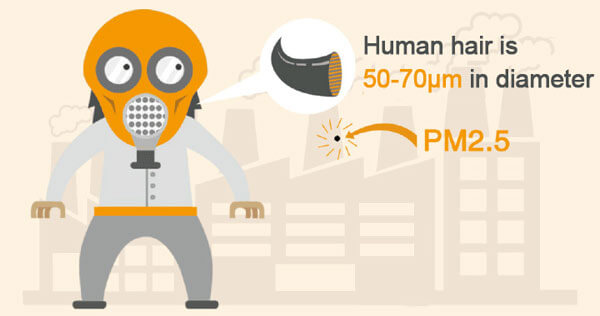
Particles larger than PM 2.5 can be intercepted by our nose hairs and secretions in the respiratory tract, but PM2.5 pollutants are small in size, strong in activity, and easy to carry harmful substances (such as heavy metals, and microorganisms). Most of them enter our lungs through breathing, causing diseases including asthma, bronchitis and cardiovascular disease. It can be suspended in the air for a long time, so the haze weather caused by fine particles is even more harmful to human health than sandstorms.
The composition of pm 2.5 is very complex, the main components are organic matter, sulfate, nitrate, ammonium salt, carbon and various metal compounds. It consists of many types of chemicals and particles, and can be partly solid particles and partly liquid. Particulate pollutants composed entirely or partly of droplets are called aerosols.
What causes pm2.5 pollution?
Although natural processes produce pm 2.5, its main source is anthropogenic emissions. PM 2.5 produced by human activities is divided into direct emissions and indirect emissions. Direct emissions mainly come from combustion processes, such as fossil fuel combustion, biomass combustion, vehicle exhaust, and waste incineration. Indirect emissions refer to gaseous pollutants (such as sulfur dioxide, nitrogen oxides, ammonia, and volatile organic compounds) produced by industrial activities, which react with water vapor in the air and sunlight to convert into pm 2.5. Due to many uncertain factors such as region, weather, climate and human activities, we cannot accurately judge which chemicals are in pm 2.5 particles.
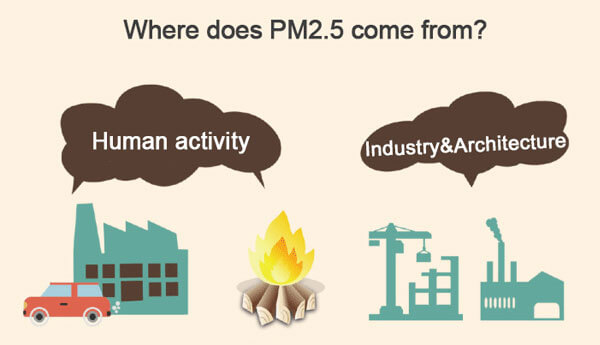
In windy sand or bad weather, indoor particulate pollution mainly comes from the outdoors. If the outside air is clean, the factors that affect indoor pm 2.5 levels mainly include smoking, kitchen cooking, interior decoration, secondary dust from housework, and animal hair.
What are the Harmful Effects of PM?
Multiple health studies have found that higher levels of pm2 5 pollutants in the air increase negative impacts, including increased incidence of respiratory disease, worsening respiratory disease symptoms, lead to heart attack and death.
Excessive inhalation of PM2.5 will increase the incidence of the respiratory system, cardiovascular system, reproductive system, and immune system, and also increase the incidence of mental illness. People living in cities with severe air pollution have a 10-15% higher risk of developing lung cancer than in cities with relatively clean air. Smog increases the risk of cancer more than smoking does, and increases the incidence of chronic cough, asthma and bronchitis.
A survey of the relationship between pm2.5 and blood pressure in the United States found that for every 10ug/M3 increase in pm 2.5 concentration, the average systolic blood pressure of subjects increased by 8.6mmHg. Another study found that the concentration of pm 2.5 is proportional to the mortality rate of patients with heart disease. If the concentration of pm 2.5 exceeds 10ug/M3, the mortality rate of patients with heart disease will increase by 20%.
Particulate matter also affects weather. People generally think that pm2 5 is just air pollution. In fact, the impact of pm2 5 on the weather may be even worse. PM2 5 can affect the rainfall process and indirectly affect meteorological changes. In addition to the salt of seawater, particulate matter is also an important source of condensation nuclei of rainwater in the atmosphere. If the amount of pm2 5 is too large, it will absorb the moisture in the sky, so that the cloud droplets in the air will not grow, and the white clouds will become less than before. In addition, pm2 5 increases the number of condensation nuclei, increasing the number of raindrops in the sky, and in extreme cases, heavy rain may occur.
There are a variety of air quality sensors and air quality detectors on the market today. Choose the best pm2.5 sensor for different monitoring environments. Accurately measure indoor or outdoor PM2.5 levels. Here are five popular air quality sensors for you.
RS-PM-*-2 is an industrial-grade particulate matter sensor that mainly measures PM2.5, PM10 and PM1.0 levels in the air. Using the principle of laser scattering measurement and screening through the unique dual-frequency data acquisition technology, the number of particles with equivalent particle size per unit volume is obtained, and the particle concentration is calculated scientifically. Measurement data can be uploaded to the free monitoring platform, users can view real-time data through the platform, and can also export, download, and print historical data.
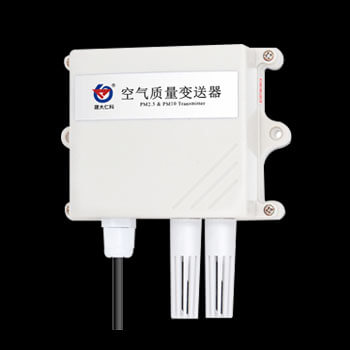
- Measuring range: PM2.5, PM10
- Installation method: wall-mounted
- Output: RS485/0-5V/0-10V/4-20mA
- Protection class: IP65
- Price: $50.3
The accuracy of this wall-mounted air quality sensor can reach 1ug/m3, and it supports simultaneous output of PM2.5 and PM10. The air quality sensor adopts advanced laser anti-attenuation technology to ensure the stability of the 0-1000ug/m3 measurement range, dual-frequency data acquisition and automatic calibration technology, and the consistency can reach +10%.
This pm sensor can be used in outdoor weather stations, dust monitoring equipment, libraries, archives, industrial plants and other places that require PM2.5 or PM10 concentration monitoring.
The Temptop M10 air quality monitor is the best instrument for indoor PM detection. It is beautiful in appearance and easy to operate. Although it’s small, it can measure four indoor pollutants, pm 2.5, AQI, TVOC and HCHO (formaldehyde). It helps detect smoke and air pollution in your house. The unique design allows users to easily move around the house and take measurements in different rooms.
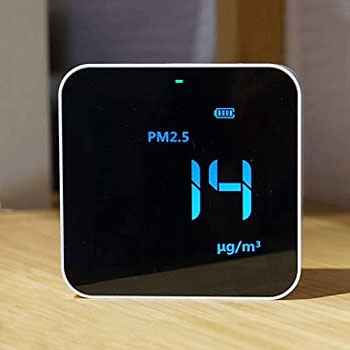
- Batteries: 1 Lithium Metal batteries required. (included)
- Mounting Type: Desk Mount
- Measure range: HCHO/PM2.5/AQI/TVOC
- Average Battery Life: 8 Hours
- Price:$89.99
This air quality monitor is responsive with the sensitive Temptop 3rd generation laser particle sensor and Dart electrochemical sensor. All operations such as power supply, interface switching, display cycle, etc. can be realized through the home button at the top. The screen is bright and clear, with a 3-color indicator light, so you can see the values from any angle.
This air quality monitor is used to detect indoor air quality in homes and offices.
This is a multi-functional air quality detector with powerful functions that can basically detect various indicators that reflect air quality. How comprehensive are the detection indicators of MG111? This small device can measure temperature, humidity, PM2.5, PM10, atmospheric pressure, light, noise, TVOC, CO2, formaldehyde, O3, CO, CH4, O2, SO2, NO2, H2, H2S, NH3, etc. It is a good choice for home or office. It is like the software we usually use. When an air element exceeds the standard, it will trigger an alarm, reminding us to take precautions when traveling and ventilate the room well.
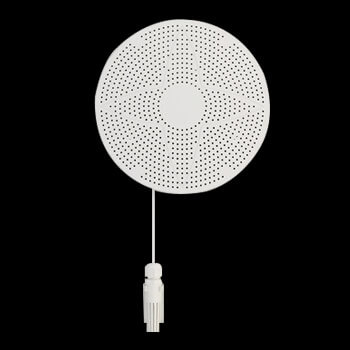
- Measurement range: temp, humidity, PM2.5, PM10, atmospheric pressure, light, noise, TVOC, CO2, formaldehyde, O3, CO, CH4, O2, SO2, NO2, H2, H2S, NH3
- Installation method: wall-mounted
- Output: RS485/WIFI
- Price: $27.25~$1027.4
This AQI sensor has two output methods, rs485 and wifi. It is wall-mounted and very beautiful to use indoors. The built-in measuring unit adopts imported sensors and computing chips, which have the characteristics of high precision, high resolution and good stability. After installation and commissioning, it can work for a long time. Maintenance is not required.
This AQI sensor is suitable for building HVAC, building energy efficiency, smart home, schools, hospitals, airport stations and other places.
Building construction will generate a lot of dust. In this environment, it is necessary to monitor the PM value to avoid environmental problems caused by the continuous increase of particle concentration. Therefore, we need an outdoor air quality sensor that can be used in harsh environments for a long time. This outdoor pm2 5 sensor developed by Renke is an ideal choice. It uses an ABS solar radiation shield on the outside to avoid damage sensor by light, rain, snow and strong wind. The louvered box-like design ensures free air circulation while preventing sand and insects enter.
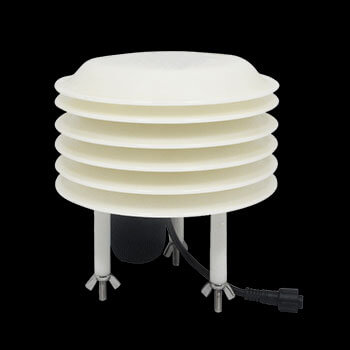
- Measuring range: PM2.5, PM10 (temperature, humidity, noise, atmospheric pressure, light optional)
- Installation method: bracket installation
- Output: RS485
- Protection class: IP68
- Price: $32.5~$154
In addition to measuring PM 2.5 and PM10 separately, this outdoor pm sensor can also add sensor modules such as temperature, humidity, light, noise, and atmospheric pressure to achieve multi-factor measurement. This appearance has a protection level of up to IP68, has a long service life, and can be monitored outdoors 24 hours a day.
This outdoor pm2 5 sensor is mainly used in outdoor environments, and can be used with dust stations and weather stations.
5. Portable PM sensor
The portable pm2 5 detector can display the dust concentration and dust filtration efficiency in real time. Using imported semiconductor laser diodes and imported optical sensors, with microcontroller technology, the measurement accuracy is high and the response is sensitive. It has a storage function and can store 100,000 pieces of data at one time. The pm2 5 meter can simultaneously measure the number of particles of various particle sizes in one sampling. The portable pm detector can detect up to 4-6 kinds of particles at the same time: PM0.3, PM0.5, PM1.0, PM 2.5, PM5.0, and PM10.
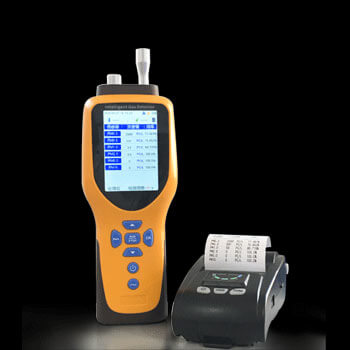
- Measurement range: PM0.3, PM0.5, PM1.0, PM2.5, PM5.0, PM10
- Power supply: 4000mA battery
- Storage capacity: 100,000 readings
- Protection class: IP65
- Price: $160
The portable pm2 5 detector is suitable for the purification efficiency test of dust particles, and can be used for dust particle concentration monitoring in various dust-free workshops, clean rooms, public environments and other places.
How to reduce pm2 5?
1. Reduce outdoor pm2.5
The typical feature of pm2 5 pollution is the diversity of pollution sources. At the same time, due to the fluidity of the medium, its spatial layout presents a cross-regional situation. This requires us to face pm2 5 pollution, not only relying on the environmental protection department, but also through the correct analysis of the pollution source, looking for measures and methods to control, only in this way can PM2.5 pollution be reduced.
Control the source
First of all, the industrial production process is an important source of pm2.5 particles. To reduce pm 2.5, we must start from the source, adopt dust removal technology and equipment, and strictly control the dust pollution caused by industrial production. Existing industrial dust removal technologies include traditional closed dust removal, filter dust removal, electrostatic dust removal, water spray or spray dust removal, etc. Controlling the emission of particulate matter from the source can greatly improve dust removal efficiency and reduce energy consumption. Developed countries such as Europe and the United States have also generally adopted this governance strategy, starting from the source and taking measures to reduce the pm 2.5 generated at one time. At the same time, strengthen dust management on construction sites and roads.
Improve energy consumption
The process of energy combustion also produces a large amount of pollutants such as pm 2.5. Especially the combustion of non-renewable resources such as oil and coal. In order to protect the environment and reduce the level of pm particles, we must improve the utilization efficiency of new energy sources and change the structure of energy consumption. Vigorously develop nuclear power, hydropower, biogas, solar energy and other clean energy sources, and increase the use of clean energy. Increase the proportion of renewable energy in the primary energy consumption structure, and reduce pollutant emissions caused by the combustion of fossil fuels such as coal and oil.
Control exhaust emissions
The sources of pm 2.5 are very complex, including fuel combustion and motor vehicle exhaust. Reducing vehicle exhaust emissions is also an effective way to reduce PM pollution. Raise vehicle emission standards and control vehicle exhaust emissions, especially diesel-fueled vehicles. Encourage people to travel green, promote the construction of public transportation infrastructure, and reduce residents’ reliance on motor vehicles for travel, thereby reducing fuel consumption and reducing air pollutants such as pm 2.5 emitted by vehicle exhaust.
2. Reduce indoor pm2.5
If outdoor pm2 5 levels are high, staying indoors is an important way to reduce exposure. You should also close windows (and close doors if possible) and run the air conditioner.
Keep the room clean
Clean the ground dust daily, and regularly clean home appliances such as air conditioners and washing machines. This can reduce the concentration of dust, hair and other substances to a certain extent. Secondly, tobacco smoke is one of the main sources of indoor air pm2 5. Laboratory studies have shown that a smoker who smokes three cigarettes in a row can cause pm 2.5 levels in the air to exceed 1700 micrograms per cubic meter at a distance of 1.5 meters from the smoker. A related study found that pm 2.5 levels in non-smoking offices are about seven times higher than those in non-smoking offices. Smoking can make indoor pm 2.5 soar instantly, so it is best not to smoke indoors.
Kitchen fumes also contain pm 2.5. Whether it is burning natural gas, liquefied gas or honeycomb, the pm 2.5 content in kitchen fumes exceeds the standard by a large amount, up to 117 times. When cooking at home, turn on the range hood and close the kitchen door, and continue to use the range hood for a few minutes after the dishes are cooked.
Open air purifier
It is very important to have an air purifier for indoors where pm2 5 levels are too high. Using an air purifier can quickly reduce the content of indoor pm 2.5 and other pollutants. Circulate and purify the original air in the room.
FAQ
1. What does pm2 5 meaning?
PM means particulate matter, and PM2 5 refers to tiny particles in the air that are less than 2.5 microns in diameter.
2. What level of pm2 5 is safe?
- The U.S. safety standard for PM2.5 is no more than 12 micrograms per cubic meter. This standard is set by the U.S. Environmental Protection Agency to protect public health and the environment.
- The EU safety standard for PM2.5 is 25 micrograms per cubic meter. This standard was enacted in 2008.
- The Canadian safety standard for PM2.5 is 30 micrograms per cubic meter. This standard is set by Environment Canada.
3. What causes pm2.5 particles?
50%-60% of PM2.5 comes from burning coal, and 20%-30% comes from fuel oil. The sulfur dioxide and nitrogen oxides emitted from coal combustion react with other pollutants in the air to form secondary particles of sulfate and nitrate, which are the main reasons for the increase of pm 2.5.
4. Can PM2 5 be removed from the body?
- The diameter is between 5 microns to 10 microns, and most of them will be excreted in the form of expectoration with the swing of bronchial cilia during coughing, which has limited damage to human health.
- Particles smaller than 5 microns in diameter enter the bronchioles and alveoli. Difficult to expel.
5. What is particulate matter?
Particulate matter is separated into three main groupings: coarse particles (PM10), fine particles (PM2. 5), and ultrafine particles (PM0. 1). These particle sizes, in general, differ in origin and health effects
6. Which is worse PM2 5 or PM10?
PM10 can enter the upper respiratory tract of the human body, and part of it can be excreted through sputum, etc., and it is also blocked by the villi inside the nasal cavity, which is relatively less harmful to human health. After being inhaled into the human body, pm 2.5 will directly enter the bronchi and enter the blood through the bronchi and alveoli. Causes diseases such as asthma, bronchitis and cardiovascular disease.

